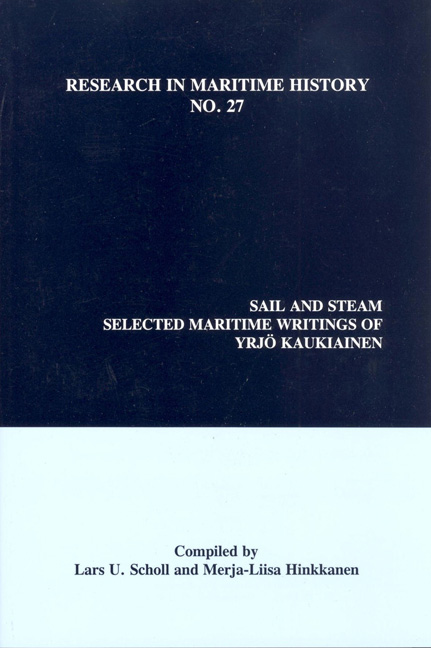Book contents
- Frontmatter
- Frontispiece
- Table of Contents
- Acknowledgements
- “Yrjö Kaukiainen: A Tribute on the Occasion of his Forthcoming Retirement as Professor of Maritime History at the University of Helsinki”
- “Yrjö Kaukiainen: A Man of the Sea”
- “Yrjö Kaukiainen and the Development of Maritime Economic History”
- “Finnish Sailors, 1750-1870”
- “Finnish and International Maritime Labour in the Age of Sail: Was There a Market?”
- “Five Years before the Mast: Observations on the Conditions of Maritime Labour in Finland and Elsewhere”
- “The Maritime Labour Market: Skill and Experience as Factors of Demand and Supply”
- “Owners and Masters: Management and Managerial Skills in the Finnish Ocean-Going Merchant Fleet, c. 1840-1880”
- “From Low-Cost to High-Cost Shipping: Finnish Maritime Labour Costs after the Second World War”
- “The Modernization of Finnish Coastal Shipping and Railway Competition c. 1830-1913”
- “British Timber Imports and Finnish Shipping 1860-1910”
- “Baltic Timber-Trade under Sail: An Example of the Persistence of Old Techniques”
- “Coal and Canvas: Aspects of the Competition between Steam and Sail, c. 1870-1914”
- “Dutch Shipping and the Swedish Navigation Act (1724). A Case Study”
- “Seamen Ashore: Port Visits of Late Nineteenth-Century Finnish Sailors”
- “Wreck-plundering by East Finnish Coastal People - Criminal Tradition or Popular Culture?”
- “From Days and Knots to Pounds and Dollars: Some Problems in the Study of the Economics of Late Nineteenth Century Merchant Shipping”
- “Tons and Tonnages: Ship Measurement and Shipping Statistics, c. 1870-1980”
- “International Freight Markets in the 1830s and 1840s: The Experience of a Major Finnish Shipowner”
- “Shrinking the World: Improvements in the Speed of Information Transmission, c. 1820-1870”
- “Yrjö Kaukiainen: A Maritime Bibliography”
“Tons and Tonnages: Ship Measurement and Shipping Statistics, c. 1870-1980”
- Frontmatter
- Frontispiece
- Table of Contents
- Acknowledgements
- “Yrjö Kaukiainen: A Tribute on the Occasion of his Forthcoming Retirement as Professor of Maritime History at the University of Helsinki”
- “Yrjö Kaukiainen: A Man of the Sea”
- “Yrjö Kaukiainen and the Development of Maritime Economic History”
- “Finnish Sailors, 1750-1870”
- “Finnish and International Maritime Labour in the Age of Sail: Was There a Market?”
- “Five Years before the Mast: Observations on the Conditions of Maritime Labour in Finland and Elsewhere”
- “The Maritime Labour Market: Skill and Experience as Factors of Demand and Supply”
- “Owners and Masters: Management and Managerial Skills in the Finnish Ocean-Going Merchant Fleet, c. 1840-1880”
- “From Low-Cost to High-Cost Shipping: Finnish Maritime Labour Costs after the Second World War”
- “The Modernization of Finnish Coastal Shipping and Railway Competition c. 1830-1913”
- “British Timber Imports and Finnish Shipping 1860-1910”
- “Baltic Timber-Trade under Sail: An Example of the Persistence of Old Techniques”
- “Coal and Canvas: Aspects of the Competition between Steam and Sail, c. 1870-1914”
- “Dutch Shipping and the Swedish Navigation Act (1724). A Case Study”
- “Seamen Ashore: Port Visits of Late Nineteenth-Century Finnish Sailors”
- “Wreck-plundering by East Finnish Coastal People - Criminal Tradition or Popular Culture?”
- “From Days and Knots to Pounds and Dollars: Some Problems in the Study of the Economics of Late Nineteenth Century Merchant Shipping”
- “Tons and Tonnages: Ship Measurement and Shipping Statistics, c. 1870-1980”
- “International Freight Markets in the 1830s and 1840s: The Experience of a Major Finnish Shipowner”
- “Shrinking the World: Improvements in the Speed of Information Transmission, c. 1820-1870”
- “Yrjö Kaukiainen: A Maritime Bibliography”
Summary
Introduction
Students of early modern maritime history are well aware of the perplexing variety of national units and rules for ship measurement. The adoption of the British “Moorsom” system by most maritime nations between 1864 and 1885 was therefore a major advance, not least for the cross-national comparability of shipping statistics. In fact, scholars have become so convinced of its superiority that its validity as a universal gauge of carrying capacity is seldom discussed. But people engaged in practical ship measurement soon learned it was less than perfect. The best proof was that a new international agreement on ship measurement was concluded in 1969 under the auspices of the International Maritime Organization (IMO). This accord introduced some major changes in the principles of ship measurement and led to significant increases in the tonnages of certain types of vessels. While the agreement took effect in 1982, re-measurement of older vessels became obligatory only in 1994.
In this article I will examine some of the main problems with the Moorsom system after 1867, when the modern principle of net tonnage was introduced. The most important questions are whether any substantial discrepancies developed between measured tonnage and actual carrying capacity and, if so, whether this was so common that the validity of shipping statistics - which were usually based on register tonnages - were endangered. Since the practical problems affected only steamers and other machine-propelled ships, I will focus on them.
The most important source problem for this kind of study is that since most statistics and official lists long recorded only register tonnages, the availability of alternative gauges of size, such as deadweight tonnage or the actual capacity of the holds, is poor. The Finnish official list of ships (Suomen kauppalaivasto - Finlands handelsflotta), for example, only started to record deadweight tonnages in 1935 and cargo capacity (in cubic feet, grain and/or bales) in the early 1950s. Fortunately, Finland's merchant fleet still included some very old vessels, which makes it possible to collect relevant data for fairly typical steamers over a lengthy time span. I have thus relied solely on this source, supplemented by a few other published Finnish ship lists, for my empirical data.
- Type
- Chapter
- Information
- Sail and SteamSelected Maritime Writings of Yrjö Kaukiainen, pp. 179 - 206Publisher: Liverpool University PressPrint publication year: 2004



